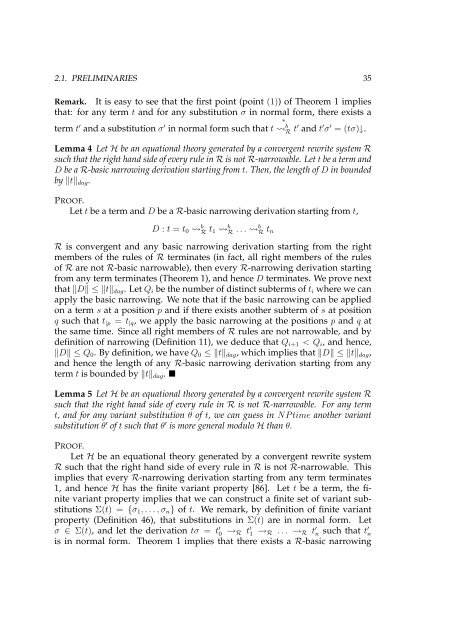Logical Analysis and Verification of Cryptographic Protocols - Loria
Logical Analysis and Verification of Cryptographic Protocols - Loria
Logical Analysis and Verification of Cryptographic Protocols - Loria
Create successful ePaper yourself
Turn your PDF publications into a flip-book with our unique Google optimized e-Paper software.
2.1. PRELIMINARIES 35<br />
Remark. It is easy to see that the first point (point (1)) <strong>of</strong> Theorem 1 implies<br />
that: for any term t <strong>and</strong> for any substitution σ in normal form, there exists a<br />
term t ′ <strong>and</strong> a substitution σ ′ ∗<br />
in normal form such that t �b R t′ <strong>and</strong> t ′ σ ′ = (tσ)↓.<br />
Lemma 4 Let H be an equational theory generated by a convergent rewrite system R<br />
such that the right h<strong>and</strong> side <strong>of</strong> every rule in R is not R-narrowable. Let t be a term <strong>and</strong><br />
D be a R-basic narrowing derivation starting from t. Then, the length <strong>of</strong> D in bounded<br />
by �t�dag.<br />
PROOF.<br />
Let t be a term <strong>and</strong> D be a R-basic narrowing derivation starting from t,<br />
D : t = t0 � b R t1 � b R . . . �b R tn<br />
R is convergent <strong>and</strong> any basic narrowing derivation starting from the right<br />
members <strong>of</strong> the rules <strong>of</strong> R terminates (in fact, all right members <strong>of</strong> the rules<br />
<strong>of</strong> R are not R-basic narrowable), then every R-narrowing derivation starting<br />
from any term terminates (Theorem 1), <strong>and</strong> hence D terminates. We prove next<br />
that �D� ≤ �t�dag. Let Qi be the number <strong>of</strong> distinct subterms <strong>of</strong> ti where we can<br />
apply the basic narrowing. We note that if the basic narrowing can be applied<br />
on a term s at a position p <strong>and</strong> if there exists another subterm <strong>of</strong> s at position<br />
q such that t|p = t|q, we apply the basic narrowing at the positions p <strong>and</strong> q at<br />
the same time. Since all right members <strong>of</strong> R rules are not narrowable, <strong>and</strong> by<br />
definition <strong>of</strong> narrowing (Definition 11), we deduce that Qi+1 < Qi, <strong>and</strong> hence,<br />
�D� ≤ Q0. By definition, we have Q0 ≤ �t�dag, which implies that �D� ≤ �t�dag,<br />
<strong>and</strong> hence the length <strong>of</strong> any R-basic narrowing derivation starting from any<br />
term t is bounded by �t�dag. �<br />
Lemma 5 Let H be an equational theory generated by a convergent rewrite system R<br />
such that the right h<strong>and</strong> side <strong>of</strong> every rule in R is not R-narrowable. For any term<br />
t, <strong>and</strong> for any variant substitution θ <strong>of</strong> t, we can guess in NP time another variant<br />
substitution θ ′ <strong>of</strong> t such that θ ′ is more general modulo H than θ.<br />
PROOF.<br />
Let H be an equational theory generated by a convergent rewrite system<br />
R such that the right h<strong>and</strong> side <strong>of</strong> every rule in R is not R-narrowable. This<br />
implies that every R-narrowing derivation starting from any term terminates<br />
1, <strong>and</strong> hence H has the finite variant property [86]. Let t be a term, the finite<br />
variant property implies that we can construct a finite set <strong>of</strong> variant substitutions<br />
Σ(t) = {σ1, . . . , σn} <strong>of</strong> t. We remark, by definition <strong>of</strong> finite variant<br />
property (Definition 46), that substitutions in Σ(t) are in normal form. Let<br />
σ ∈ Σ(t), <strong>and</strong> let the derivation tσ = t ′ 0 →R t ′ 1 →R . . . →R t ′ n such that t ′ n<br />
is in normal form. Theorem 1 implies that there exists a R-basic narrowing
















